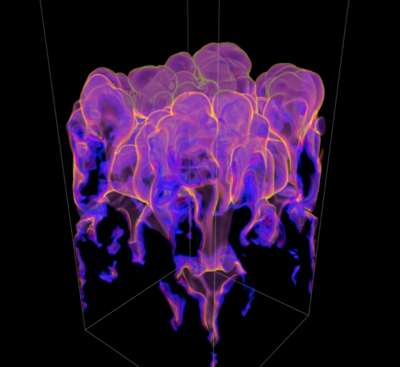Thermonuclear Supernovae
For single stars whose mass is less than approximately 8 times the mass of the sun, their ultimate fate is to become a Red Giant star and ultimately loose their hydrogen-rich envelope as a Planetary Nebula. The core of the star becomes a White Dwarf, composed of Helium or mixtures of Carbon and Oxygen or Oxygen and Neon, depending on the original mass of the star. Left alone, this white dwarf slowly cools and fades from view.
However, if the white dwarf has a binary companion, as many stars do, then a catastrophic death as a thermonuclear supernova is a possibility. With little hydrogen or helium present on the surface of the white dwarf, lines from these atoms are absent in the supernova spectra and the resulting supernova is classified as a Type Ia supernova.
Members of our group are engaged in several areas of research on Type Ia supernovae. Our research on better solution methods for thermonuclear kinetics is also highly relevent to thermonuclear supernovae. Understanding these stellar explosions is particularly important in light of the fact they provide the means to probe the evolution of the Universe as a whole. Indeed, observations of Type Ia supernovae and conclusions based on them have led to the startling fact our universe is expanding at an accelerated rate, which has significant implications for its future and ultimate fate.
Thermonuclear Flames in Type Ia Supernovae (Messer with Calder and the FLASH Center)
Type Ia supernovae are driven by thermonuclear runaway. The challenge here is the modeling of a turbulent flame, centimeters thick, in a white dwarf star the size of the Earth. Thus, three-dimensional simulations of chemically reactive flows are required, with realistic sub-grid models. (Publications: 1,2)
Thermonuclear Supernova Progenitors (Hix with Starrfield, Timmes, Sion & Sparks)
If we accept the standard “Chandrasaekar mass” model for a thermonuclear supernova, it is important to understand how the star reaches this mass. Our understanding of stellar evolution indicates that the most massive carbon-oxygen white dwarf born from a read giant is 1.0-1.1 solar masses, thus accretion must provide a sizeable fraction of the 1.4 solar mass at explosion. Standard models for this accretion process, assuming the steady burning hypothesis, do not provide a good match to the observed Super Soft Sources (SSS), which we believe our the progenitor systems for thermonuclear supernovae. Our simulations indicate that accretion at a lower rate onto a white dwarf made hot by a recent nova explosion are a better match to the SSS observations, raising questions about the steady burning hypothesis. (Publications: 1)
Tidally-Induced Thermonuclear Supernovae(Hix with Rosswog, Ramirez-Ruiz)
Accretion from a companion is not the only way to compress a white dwarf. The passage of a white dwarf near a massive black hole can lead to tidal compression. Our simulations indicate that passage close to a black hole with a mass roughly 1000 times that of the sun can ignite a thermonuclear runaway in a helium or carbon-oxygen white dwarf. For a more massive white dwarf, our simulations produce more than 0.5 solar mass of 56Ni, comparable to a Chandrasaekar mass model. While these events are almost certainly too rare to represent the primary mechanism for Type Ia supernovae, they may provide a unique signal of the presence of these intermediate mass black holes within globular clusters. (Publications: 1, 2, 3)



